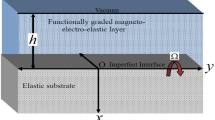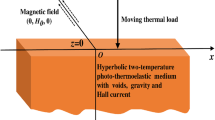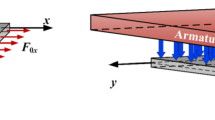Abstract
The article considers the thermal shock of large elastic elements of a spacecraft leaving the Earth's shadow. The stress–strain state of the element is analyzed to estimate additional microaccelerations from a thermal shock. Beside the most dangerous cases, the possible initial deflection of the elastic element at the time of the thermal shock is also considered. This deflection can be related to the natural vibrations of elastic elements. The obtained results demonstrate a significant decrease in additional microaccelerations from a thermal shock at certain values of the initial deflection. It was also found that an elastic element can lose stability when bending stresses are added to thermal stresses. The results of the investigation can be used in the design and usage of small technological spacecraft.







Similar content being viewed by others
References
Anshakov, G.P., Belousov, A.I., Sedelnikov, A.V., et al.: Efficiency Estimation of Electrothermal Thrusters Use in the Control System of the Technological Spacecraft Motion. Russian Aeronautics 61(3), 347–354 (2018)
Belousov, A.I., Sedelnikov, A.V.: Probabilistic estimation of fulfilling favorable conditions to realize the gravity-sensitive processes aboard a space laboratory. Russian Aeronautics 56(3), 60–63 (2013)
Belousova, D.A., Serdakova, V.V.: Modeling the temperature shock of elastic elements using a one-dimensional model of thermal conductivity. Int J of Modeling, Simulation, and Sci Computing. 11(6), 2050060 (2020)
Gorozhankina, A.S., Orlov, D.I., Belousova, D.A.: Problems of development motion control algorithms for a small spacecraft for technological purpose taking into account temperature deformations of solar panels. J. Conf. Ser. 1546, 012015 (2020)
Ivanov, D.S., Meus, S.V., Ovchinnikov, A.V., et al.: Methods for the vibration determination and parameter identification of spacecraft with flexible structures, Journal of Computer and System Science. International 56, 311–327 (2017)
Li, Q., Liu, L., Yang, H.: High accuracy and multi-target acquisition, pointing and tracking under satellite micro-vibrations. Microgravity Sci. Technol. 32(4), 715–727 (2020)
Lyubimova, T., Zubova, N., Shevtsova, V.: Effects of Non-Uniform Temperature of the Walls on the Soret Experiment. Microgravity Sci. Technol. 31(1), 1–11 (2019)
Manu O., Verna J.K., Karla P., et al.: Performance analysis of effect of vibrations on solar panel conversion efficiency, International conference on smart technology for smart nation, 635–638 (2017)
Oda M., Hagiwara Yu., Suzuki S., et al.: Measurement of satellite solar array panel vibrations caused by tnermal snap and gas jet thruster firing, in: Resent advances in vibrations analysis, Chapter 7, 123–140 (2011)
Perminov, A.V., Lyubimova, T.P., Nikulina, S.A.: Influence of High Frequency Vertical Vibrations on Convective Regimes in a Closed Cavity at Normal and Low Gravity Conditions. Microgravity Sci. Tech. 33, 55 (2021)
Sedelnikov, A.V.: Fractal quality of microaccelerations. Microgravity Sci. Technol. 24(5), 345–350 (2012)
Sedelnikov, A.V., Orlov, D.I.: Development of control algorithms for the orbital motion of a small technological spacecraft with a shadow portion of the orbit. Microgravity Sci. Technol. 32(5), 941–951 (2020)
Sedelnikov, A.V., Orlov, D.I.: Analysis of the significance of the influence of various components of the disturbance from a temperature shock on the level of microaccelerations in the internal environment of a small spacecraft. Microgravity Sci. Tech. 33(2), 22 (2021)
Sedelnikov, A.V.: Algorithm for restoring information of current from solar panels of a small spacecraft prototype “Aist” with help of normality conditions. Journal of Aeronautics, Astronautics, and Aviation 54(1), 67–76 (2022)
Sedelnikov, A.V., Serpukhova, A.A.: Simulation of a flexible spacecraft motion to evaluate microaccelerations. Russian Aeronautics 52(4), 484–497 (2009)
Sedelnikov, A.V., Serdakova, V.V., Khnyreva, E.S.: Construction of the criterion for using a two-dimensional thermal conductivity model to describe the stress-strain state of a thin plate under the thermal shock. Microgravity Sci. Tech. 33(6), 65 (2021)
Sharifulin, V.A., Lyubimova, T.P.: A Hysteresis of Supercritical Water Convection in an Open Elongated Cavity at a Fixed Vertical Heat Flux. Microgravity Sci. Technol. 33, 38 (2021)
Shen, Z., Hu, G.: Thermally Induced Dynamics of a Spinning Spacecraft with an Axial Flexible Boom. J. Spacecr. Rocket. 52(5), 1503–1508 (2015)
Shen, Z., Tian, Q., Liu, X., Hu, G.: Thermally induced vibrations of flexible beams using Absolute Nodal Coordinate Formulation. Aerosp. Sci. Technol. 29, 386–393 (2013)
Shevtsova, V.: Investigation of diffusive and optical properties of vapour-air mixtures: The benefits of interferometry, Elsevier Ltd. (2021)
Shevchenko, V., Mialdun, A., Yasnou, V., Y. Lyulin, V., Ouerdane, H., Shevtsova, V.: Investigation of diffusive and optical properties of vapour-air mixtures: The benefits of interferometry”. Chem. Eng. Sci. 233, 116433 (2021)
Taneeva, A.S.: The formation of the target function in the design of a small spacecraft for technological purposes. J. Phys. Conf. Ser. 1901(1), 012026 (2021)
Acknowledgements
The work was carried out within the framework of the project "Development of scientific and technical foundations and design solutions that ensure the implementation of the required level of microaccelerations on board small spacecraft" (No. 22-19-00483).
Author information
Authors and Affiliations
Corresponding author
Ethics declarations
Conflict of interest
The authors declare that they have no conflict of interest.
Additional information
Publisher's Note
Springer Nature remains neutral with regard to jurisdictional claims in published maps and institutional affiliations.
Rights and permissions
About this article
Cite this article
A.V., S., V.V., S., S.V., G. et al. Consideration of the Initial Deformation From Natural Oscillations of Large Elastic Elements of the Spacecraft When Assessing Microaccelerations From Thermal Shock Using a Two-dimensional Model of Thermal Conductivity. Microgravity Sci. Technol. 34, 22 (2022). https://doi.org/10.1007/s12217-022-09938-3
Received:
Accepted:
Published:
DOI: https://doi.org/10.1007/s12217-022-09938-3




